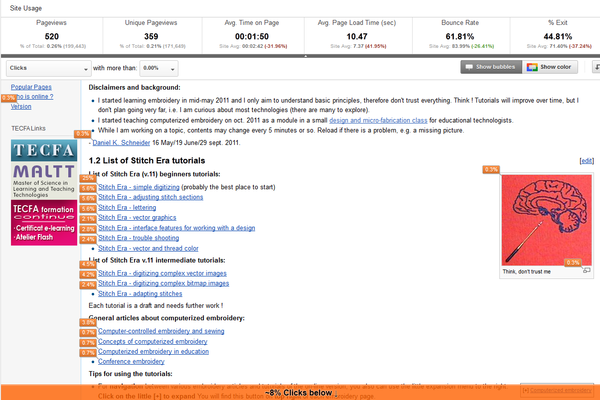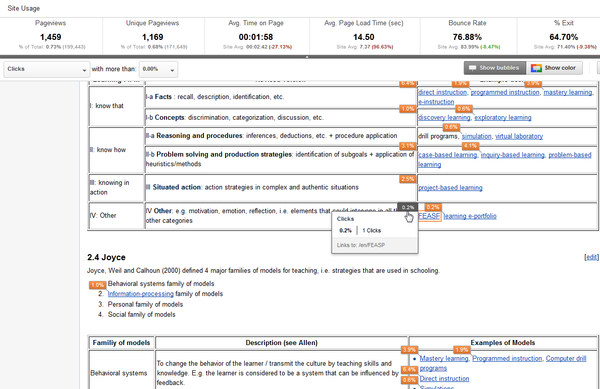Google analytics
 From EduTechWiki - Reading time: 4 min
From EduTechWiki - Reading time: 4 min
Google analytics is a a google services that allows insights into website traffic with Advanced Segmentation, Custom Reporting, Motion Charts, and more.
See also
- Google webmaster tools which gives you very different information, i.e. its data is based on the google search engine.
- Google website optimizer which allows to create so-called A/B or multivariate tests (i.e. some kind of light-weight quasi-experimental playing with variants of landing pages)
- Piwik
Tool overview[edit | edit source]
The services includes several groups of tools, that allows a website owner to learn about the users and their behavior.
As of March 2012, Google Analytics includes five group of Tools plus a custom reporting tool that allows to do more fine grained analysis.
- Audience (demographics, behavior, technology, social, mobile, and visitors flow tool)
- Advertising (not explained here, since we don't use that)
- Traffic sources (including search terms used before landing on a page)
- Content (information about which pages are accessed, search terms used with internal search, and more specialized information such as AdSense)
- Conversions
A more expanded list is below:
- Audience
- Overview
- Demographics
- Location
- Language
- Custom Variables
- User Defined
- Behavior
- New vs Returning
- Frequency & Recency
- Engagement
- Technology
- Browser & OS
- Network
- Social
- Engagement
- Action
- Pages
- Mobile
- Overview
- Devices
- Visitors Flow
- Advertising
- AdWords
- Traffic Sources
- Overview
- Sources
- All Traffic
- Direct
- Referrals
- Search
- Overview
- Organic
- Paid
- Campaigns
- Search Engine Optimization
- Queries
- Landing Pages
- Geographical Summary
- Content
- Overview
- Site Content
- Pages
- Content Drilldown
- Landing Pages
- Exit Pages
- Site Speed
- Site Search
- Overview
- Usage
- Search Terms
- Pages
- Events
- AdSense
- In-Page Analytics
- Conversions
- Goals
- Overview
- Goal URLs
- Reverse Goal Path
- Funnel Visualization
- Goal Flow
- Ecommerce
- Multi-Channel Funnels
- Goals
The DashBoard[edit | edit source]
A default Dashboard shows some key data like daily visits, average time on site), conversions, traffic type and time on site by country.
Site owners can configure their own dashboards (in the plural).
Audience tools[edit | edit source]
Location[edit | edit source]
Purpose: Does what it says, displays location .
Traffic sources[edit | edit source]
(to do)
Content[edit | edit source]
Content includes six groups of analytics:
- Site Content
- Site Speed
- Site Search
- Events
- AdSense
- In-Page Analytics
Site Content and In-Page Analytics are probably the most interesting tools for academic and educational web sites like this one.
Site Content[edit | edit source]
(to do)
Site search[edit | edit source]
This reports search URLs used with an internal search engine.
In-Page Analytics[edit | edit source]
Purpose: Allows to see on what links users clicked.
This is an interesting tool for finding out quickly whether (a) users actually make use of the menu interface and (b) what other links they follow up. By default, the bubbles shows percentages (with respect to page views). The following three screen captures illustrate the principle. The third one also shows that one get get more details by mousing over bubble. Overal, principles known from user interaction and experience design are confirmed. Users use menu items sparingly (however some items are not indexed and external links are not tracked), rarely follow up links are a not interested in who wrote something.



Conversions[edit | edit source]
In EduTechWiki, there is some advertisement about our Master program in Educational Technology. Although the purpose of EduTechWiki is not to make propaganda about this program, it could help attract future students, in particular in the french version. We therefore could define the goal that users should click on the above propaganda site. The amount of users / vistors that click is called the conversion rate.
How to
Goals can be added by clicking on the Admin Tab (top right). Then select the Goals tab. You can set a total of four sets of goals that include each five goals (either URL Destination, Time On site, Page/Visit, or Event).
How to register a site[edit | edit source]
- Get a Google account and sign up to analytics
- Modify all your web pages to include a javascript fragment
A simple Mediawiki extension[edit | edit source]
In the past, I edited the skin files and place the "old" Google code just before the </body> tag.
We now use extension code (makes updating easier for example). Currently, for MW release 1.16.4, we use the following simple extension code found in Extension talk:Google Analytics Integration page at Mediawiki. Its author is unkown.
File 'extensions/GoogleAnalytics.php' (change "UA-xxxxxx-x" to your own key):
<?php
global $wgGoogleAnalytics;
$wgGoogleAnalytics = false;
$wgHooks['ParserAfterTidy'][] = 'efGoogleAnalytics';
function efGoogleAnalytics() {
global $wgOut;
global $wgGoogleAnalytics;
if (!$wgGoogleAnalytics) {
$funcOutput = <<<GASCRIPT
<script type="text/javascript">
var gaJsHost = (("https:" == document.location.protocol) ? "https://ssl." : "http://www.");
document.write(unescape("%3Cscript src='" + gaJsHost + "google-analytics.com/ga.js' type='text/javascript'%3E%3C/script%3E"));
</script>
<script type="text/javascript">
try{
var pageTracker = _gat._getTracker("UA-xxxxxx-x");
pageTracker._trackPageview();
} catch(err) {}
</script>
GASCRIPT;
$wgOut->addScript($funcOutput);
$wgGoogleAnalytics = true;
}
return true;
}
?>
Add in LocalSettings.php:
require_once($IP.'/extensions/GoogleAnalytics.php');
Links[edit | edit source]
- Alternatives
- Piwik Most popular open source tool. Either download the free server and keep total control or buy a hosting solution.
- At Google
- Google analytics homepage
- Google Analytics Help. Probably the best place to start.
- Google Conversion University. A set of lessons to prepare for the Google Analytics Individual Qualification (IQ) test or to simply become a more knowledgeable Google Analytics user. Although the tutorials are very well done, they are videos. Videos are fine for people with low technical background and low technical reading skills, but take too much time ...
- The Google Analytics Blog
- Videos made by Google
- Google Analytics (9 min. video at YouTube). An older version is here
- Google Analytics in 60 Seconds (You Tube playlist)
There are many videos about Google Analytics. A good short list of videos is The Ultimate Google Analytics Video Guide
- (Other) introductions
Good introductions and tutorials are difficult to find, since there are many websites made by SEO services that just try to attract customers. As of March 2012, about a third of the top search results point to the same useless web site that requires registration for getting an unspecified report.
- Google Analytics (Wikipedia)
- How to Use Google Analytics for Beginners Includes installation tips. A bit outdated, but still useful.
- Beginner’s Guide to Google Analytics Small introduction on how to use the data made in 2008. Good, but as of Feb 2012 refers to the older interface.
- Resource web sites (links)
 KSF
KSF